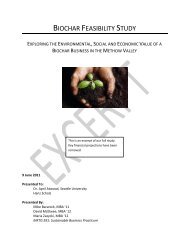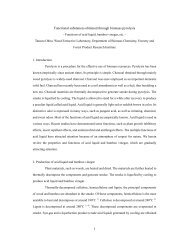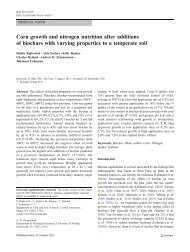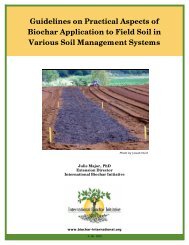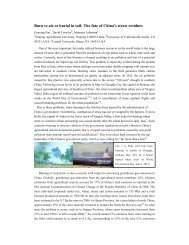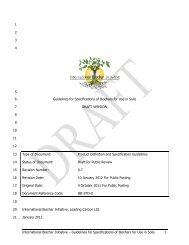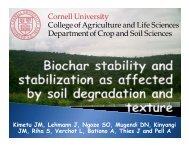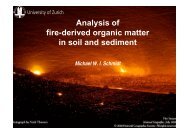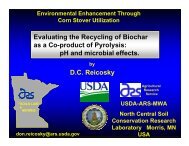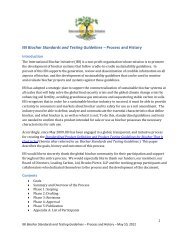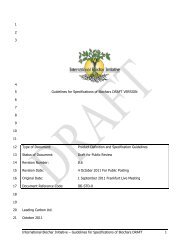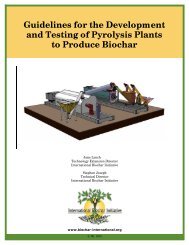Standardized Product Definition and Product Testing Guidelines for ...
Standardized Product Definition and Product Testing Guidelines for ...
Standardized Product Definition and Product Testing Guidelines for ...
Create successful ePaper yourself
Turn your PDF publications into a flip-book with our unique Google optimized e-Paper software.
1<br />
2<br />
3<br />
4<br />
5<br />
6<br />
7<br />
8<br />
9<br />
10<br />
11<br />
12<br />
13<br />
14<br />
15<br />
16<br />
17<br />
18<br />
19<br />
20<br />
21<br />
22<br />
23<br />
24<br />
25<br />
26<br />
27<br />
28<br />
29<br />
30<br />
31<br />
32<br />
control <strong>and</strong> reference pH samples <strong>and</strong> electrode probes have been adapted <strong>for</strong> use with<br />
biochar, as follows: where the TMECC methodology recommends a 1:5 (v:v or w:w) 3 solution<br />
of compost:deionized water, a 1:20 (w:v) 4 solution of biochar:deionized water should be used<br />
<strong>for</strong> biochar pH <strong>and</strong> EC analysis, following Rajkovich et al (2011). Similarly, additional time<br />
should be allotted <strong>for</strong> solution equilibration after the combination of deionized water <strong>and</strong><br />
biochar. Following Rajkovich et al (2011), 1.5 hours should be provided <strong>for</strong> the shaking <strong>and</strong><br />
equilibration of biochar-deionized-water solutions prior to pH <strong>and</strong> EC analysis. Upon completion<br />
of the shaking <strong>and</strong> equilibration phase, pH <strong>and</strong> EC analysis may be conducted on the same<br />
samples, rather than making separate replicates <strong>for</strong> pH <strong>and</strong> EC. To complete the pH <strong>and</strong> EC<br />
analysis follow methodologies 04.10 <strong>and</strong> 04.11 of the TMECC methodology (US Composting<br />
Council <strong>and</strong> US Department of Agriculture (2001)).<br />
Earthworm Avoidance <strong>and</strong> Germination Inhibition Assay<br />
The Earthworm Avoidance <strong>and</strong> Germination Inhibition Assay analyses follow procedures<br />
outlined by Van Zwieten et al 2010. The recommended approach <strong>for</strong> biochar analysis is to<br />
follow Van Zwieten et al’s methods, as they are drawn from the initial 1984 OECD <strong>and</strong> ISO<br />
17512 - 1:2008 methodologies, <strong>and</strong> to report earthworm behavior as it relates to the avoidance<br />
of biochar-soil, <strong>and</strong> seedling germination as it relates to the failure to germinate in biochar-soil.<br />
Lettuce (Lactuca sativa L.) is the most widely recommended species to use in germination<br />
assessments, due to its sensitivity. Other species that can be used are found within the OECD<br />
(1984b) methodology. The primary approach to the earthworm avoidance test is drawn from<br />
ISO 17512 – 1:2008, with instructions on soil matrix blending from the OECD (1984a)<br />
methodology. Further augmentations of Van Zwieten et al’s approach should follow Li et al<br />
(2011) to ensure that adequate wetting of soil <strong>and</strong> biochar-soil blends is achieved <strong>for</strong> the<br />
duration of the Earthworm Avoidance test. Results should be reported as a “fail” to reflect a<br />
statistically significant preference of the worms to avoid biochar-blended soils, or a failure of<br />
seedling germination <strong>and</strong> growth in biochar-blended soils, thus rejecting the null-hypothesis<br />
that there is no difference between biochar-soil blends <strong>and</strong> soil within the test. Results can be<br />
reported as a “pass” where there is no difference of worm preference or germination <strong>and</strong><br />
seedling growth success between biochar-soil blends <strong>and</strong> soil, or where biochar-soil blends are<br />
preferred; both conditions are considered to pass these tests. The purpose of the analyses is to<br />
determine whether adding biochar to soil has an effect on worm behaviour <strong>and</strong> seed<br />
3 v:v – volume:volume denotes a ratio based on equivalent units of volume measurement in a dilution or<br />
blend (e.g. a 1:5 v:v biochar:water blend indicates the need to blend 1 ml of biochar with 5 ml of water)<br />
w:w – weight:weight denotes a ratio based on equivalent units of weight measurement in a dilution or<br />
blend (e.g. a 1:5 w:w biochar:soil blend indicates the need to blend 1 g of biochar with 5 g of soil)<br />
4 w:v – weight:volume denotes a blend or dilution ratio expressed as grams of solid per milliliter of liquid.<br />
(e.g. a 1:20 w:v biochar:water blend indicates the need to blend 1 mg of biochar with 20 ml of water)<br />
<strong>St<strong>and</strong>ardized</strong> <strong>Product</strong> <strong>Definition</strong> <strong>and</strong> <strong>Product</strong> <strong>Testing</strong> <strong>Guidelines</strong> <strong>for</strong> Biochar That Is Used in Soil 25



